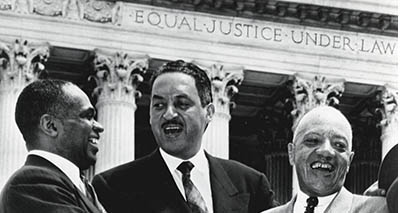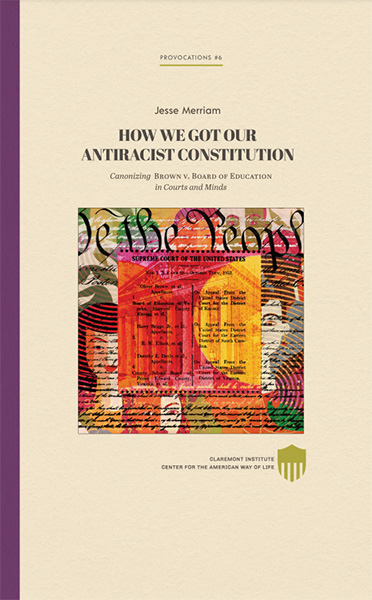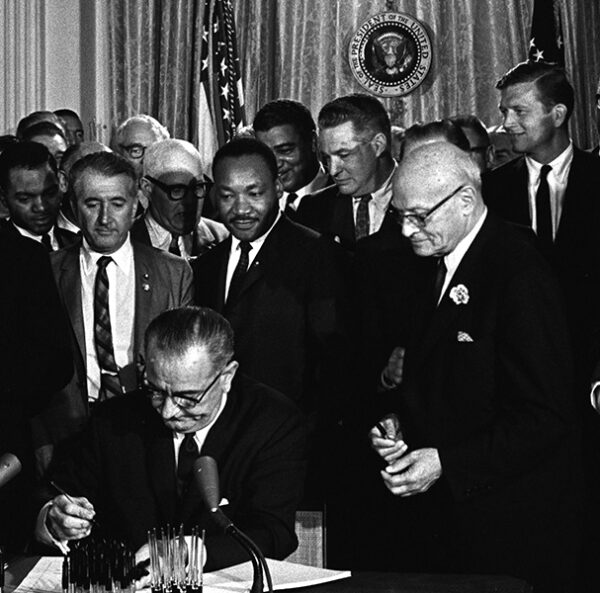How America Got an Antiracist Constitution
F. Roger Devlin, American Renaissance, July 14, 2023

Credit Image: © Keystone Press Agency/ZUMA Press Wire
Subscribe to future audio versions of AmRen articles here.
Jesse Merriam, How We Got Our Antiracist Constitution: Canonizing Brown v. Board of Education in Courts and Minds, Claremont Press, 2023, 48 pages, $9.00 paper, $3.50 kindle
Jesse Merriam is a young associate professor of government at Patrick Henry College in Virginia. This monograph was published last month as part of a series by the Claremont Institute. While other critics have pointed to an overly broad interpretation of the 14th Amendment’s “equal protection” clause as the primary fig leaf under which antiracist ideology has been smuggled into Constitutional law, Dr. Merriam blames instead what he calls the “canonization” of the Supreme Court’s 1954 desegregation ruling in Brown v. Board of Education.

Canonization means that an ordinary court decision comes to have an authority outweighing the provisions of the US Constitution itself, even taking on a quasi-religious status. Dr. Merriam calls Brown “the paradigmatic case.” So much influence has this decision acquired that some scholars speak of a “Brown Test” by which “no constitutional theory or interpretation is permissible if it is inconsistent with the Brown decision or any of the principles and values that follow from that decision.”
Toward the end of the 1920s, the Garland Fund, endowed by a wealthy communist named Charles Garland, made a $100,000 grant to the NAACP. The organization used this money to hire Harvard Law Professor Nathan Margold to develop a litigation strategy for overturning school segregation. Using the “Margold Report” as a guide, the NAACP fought segregation through the courts for over two decades, and in 1954, it finally convinced the Supreme Court to order desegregation.
The Court was unable to find any evidence that the framers of the 14th Amendment had meant to outlaw segregation. It therefore decided that segregated schools produced “feelings of inferiority” in black children. This gave such “feelings” Constitutional status, and claimed for the federal judiciary the power to overrule any law or government action that might cause them. Thus, the Court required desegregation as the remedy. Even the reasoning is faulty: It is far more likely that segregation protected black children from comparisons with whites, but the Court’s idea has gone largely unchallenged.

Justice Thurgood Marshall, later a member of the Supreme Court of the United States, was formerly the lead attorney on the Brown v. Board of Education case. (Credit Image: Arthur Grace/ZUMAPRESS.com)
At first, most school boards tried to comply with Brown through “freedom of choice,” which let parents decide which schools their children would attend. But it soon became apparent that both white and black parents generally wanted their children to attend schools with their own race. The Department of Health, Education, and Welfare therefore issued guidelines stating that “freedom of choice” plans were permissible only if they produced integration; in other words, parents were free to choose only if they made the right choice. Whereas the original Brown decision had forbidden discrimination only by certain government actors, this rejection of “freedom of choice” brought private discrimination within the purview of government.
Liberals lead, conservatives follow
In the early years after Brown, it was not uncommon to encounter criticism of this legal reasoning even from people who favored desegregation. For example, in 1959, eminent legal scholar and New Deal liberal Herbert Wechsler stated that he could not find a basis for extending freedom of association to parents who preferred to send their children to integrated schools while denying such freedom to other parents. He published this argument in a Harvard Law Review article, “Toward Neutral Principles of Constitutional Law,” which became the fifth most cited law review article in American history.
That same year, political philosopher Hannah Arendt presciently suggested that desegregation might serve as a catalyst for a totalitarian movement organized around the elimination of private interpersonal discrimination, with the government empowered to monitor and regulate all interpersonal actions. Arendt’s article was met with furious criticism from her fellow liberals, and she declined to pursue the argument further. Liberal criticism of Brown dried up by the 1960s. Herbert Wechsler even shifted his position on judicial power to comply with the liberal position.
Conservatism is sometimes criticized because, while purporting to defend what Russell Kirk called “the permanent things,” it often ends up being identical to the progressivism of a few years earlier. This happened with Brown. Dr. Merriam found that between its founding in 1955 and 1968, National Review, often described as conservatism’s flagship publication, published at least 35 articles on Brown: “I was unable to find a single one that did not treat the decision negatively.” That opposition broke down in the 1970s.
In January 1970, Pres. Richard Nixon nominated Judge Harrold Carswell to the Supreme Court. As Dr. Merriam explains:
Carswell was a Southerner who had openly criticized Brown and the civil rights movement. As it became apparent that the Senate would reject Judge Carswell’s nomination because of his statements on Brown, Nixon sought to distance himself from Carswell by giving a speech “to reaffirm [his] personal belief that the 1954 decision [had been] right in both constitutional and human terms.”
The next year, Pres. Nixon nominated William Rehnquist to the Supreme Court. Senators grilled him on Brown. Rehnquist refused to express his personal views on the case, but describing it as “settled law.” After the nomination moved to floor debates, Newsweek published a 1952 memo Rehnquist had written as a law clerk in support of Plessy v. Ferguson, the 1896 decision upholding the constitutionality of segregation. Dr. Merriam relates what followed:
To avoid Judge Carswell’s fate, Rehnquist took the extraordinary measure of writing a letter to the chairman of the Senate Judiciary Committee. Rehnquist explained how he had not been afforded an opportunity in his confirmation hearing to pledge his personal commitment to Brown, because the hearing focused on the legal status of the decision, not Rehnquist’s own views.
To clarify any ambiguity, Rehnquist pledged his personal fidelity to Brown, ending the letter with the following proclamation: “I wish to state unequivocally that I fully support the legal reasoning and the rightness from the standpoint of fundamental fairness of the Brown decision.”
Rehnquist got his Supreme Court seat, and a new principle was established: participation in American public life demanded agreement with Brown.
Conservatives got the message:
In 1973, National Review featured two non-negative treatments of the Brown decision, with each article criticizing the decision but finding something good to say about it. These two articles were written by William F. Buckley and James Kilpatrick — two men who, just a decade earlier, had been the publication’s fiercest critics of Brown. In August 1976, Jack Chatfield — a civil rights activist — wrote the first pro-Brown article for National Review.
From approval to reverence
Also during the 1970s, and independently of the debate over Brown, a school of thought known as “originalism” began gaining ground among conservatives. Often traced back to an article published by Robert Bork in 1971, originalism holds that all statements in the Constitution must be interpreted based on the original understanding at the time of enactment. By 1985, the doctrine was being publicly embraced by Pres. Ronald Reagan’s attorney general Edwin Meese.
In 1987, Pres. Reagan nominated Robert Bork to a seat on the Supreme Court and the stage was set for a showdown between originalism and Brown:
Although he had never explicitly challenged Brown, [Bork] was a vociferous critic of the Warren Court’s expansive interpretation of the Fourteenth Amendment, which raised questions about the centerpiece of that legacy — Brown and related civil rights cases. Even though Bork did end up defending Brown in his confirmation hearing, many senators found his commitment to Brown and civil rights wanting, resulting in the Senate’s refusal to confirm him. A new rule governing the federal judiciary emerged: If a judge endorsed a particular method of interpreting the Constitution, that method had to yield Brown as the right decision.
It took eight more years, but in 1995 a law professor named Michael McConnell “wrote the first sustained defense of Brown as an originalist matter.” Dr. Merriam describes this as a watershed moment because it meant that conservatives could henceforward treat civil rights as a conservative position. Within a few years, conservative activists were using Brown to score points against their opponents. Clint Bolick, e.g., a defender of school voucher programs, portrayed his opponents as
“opposing a program whose primary beneficiaries were black schoolchildren.” By using this strategy, Bolick sought to “savage” anyone who opposed vouchers “as a modern-day Orval Faubus, blocking the schoolhouse doors to minority schoolchildren.” This logic ended up playing a central role in Bolick’s argument in the Wisconsin Supreme Court, where he rested his defense on “the sacred constitutional promise of equal educational opportunities articulated in Brown.” With this conservative weaponization of Brown, the canonization process was complete. The result is the world we inhabit today, where every public official must adhere to the belief that Brown constitutes the moral core of our constitutional order.
Once again, these developments were reflected in the pages of National Review in its 50th anniversary in 2004, with a celebration of Brown as the embodiment of the American ideal: “Over the last twenty years, many National Review writers have even invoked a religious tone in discussing Brown — claiming that the decision speaks ‘eternal truths,’ is a ‘hallowed decision,’ and ‘definitively established a magnificent new public morality that racism is wrong.’”

George W. Bush hugs Cheryl Brown Henderson at the opening of the Brown v Board of Education National Historic Site in Topeka, Kansas, on Monday, May 17, 2004. (Credit Image: © Delores Johnson/TNS via ZUMA Press Wire)
With such a mood prevailing, we cannot be surprised at behavior like that of Amy Coney Barrett at her 2020 Supreme Court confirmation hearing, during which she
explained how, as a mother of two adopted black children, she found George Floyd’s death “very, very personal” — so personal that […] she “wept” with her black daughter over the “kind of brutality” that “would be a risk to her [black] brother or [future] son.” Before the canonization of Brown, such a personal diversion about weeping with one’s child would be seen as bizarre in a confirmation hearing focusing on judicial temperament and legal acumen.
Today, it appears to be a qualification for serving on the nation’s highest court.
The Constitution sacrificed to antiracism
According to Dr. Merriam, the canonization of Brown has narrowed two classes of constitutional guarantees previously enjoyed by Americans: 1) structural guarantees, including federalism and the state action doctrine, and 2) the right of private parties to free association.
Federalism gives states authority independent of the federal government, whose own authority is limited to those powers enumerated in the Constitution. According to Dr. Merriam, the civil rights revolution has nearly eliminated federalism. He points to the expansion of the federal judiciary’s authority through the “incorporation doctrine,” under which state and local governments are subject to many Constitutional principles originally intended only to limit federal authority. He can be faulted for failing to mention that the process of incorporation began well before Brown, but he is correct that in the years since 1954, the supposed need to fight racial discrimination has become an important pretext for expanding judicial power.
Congress also unilaterally expanded its own power with the Civil Rights Act of 1964, citing its Constitutional authority to claim that it regulated interstate commerce, thus justifying regulation of interpersonal relations. The Supreme Court rejected Tenth Amendment arguments against this intervention in private and local affairs, and upheld the constitutionality of the Civil Rights Act, thereby effectively reading the Tenth Amendment out of the Constitution.

Lyndon B. Johnson signs the Civil Rights Act on July 2, 1964. (Credit Image: © White House/ZUMA Wire/ZUMAPRESS.com)
The Constitution was originally meant to limit only what government could do, not the actions of private citizens or groups. This is known as the “state action doctrine.” The Thirteenth Amendment did make an exception to this principle in order to forbid slavery, but for three-quarters of a century it remained the only exception. Then, in the 1940s, the Supreme Court began carving out new exceptions for explicitly racial reasons. In 1948, it declared racially restrictive housing covenants unconstitutional on the shaky grounds that enforcement required judicial action. In 1961, it ruled against a restaurant that did not serve black customers on the grounds that the restaurant rented space from a state-owned parking authority, thereby making the restaurant’s discrimination “state action.” In 1967, the Court ruled against a private landlord on the grounds that a recent amendment to California’s state Constitution explicitly permitting housing discrimination had provided the “incentive” for him to discriminate, and the existence of such an “incentive” turned the man’s discrimination into “state action.” In 1973, it ruled that a private school could not exclude blacks because it participated in a state program that provided free textbooks to private schools, making its discrimination “state action.”
Dr. Merriam writes: “Homeowners, restaurants, landlords, private schools — these are paradigmatic private actors. Before the civil rights revolution, it would have been unfathomable to consider them state actors.” But where racial discrimination is involved, no legal pretext is too absurd to keep the Supreme Court from intervening to prohibit it.
Freedom of association is never explicitly mentioned in the Constitution, but it hardly needed to be; it constituted, in Dr. Merriam’s words, “the core liberty in the Founders’ conception of natural rights.” Before the revolution that followed the Brown decision, federal and state courts regularly upheld the principle. For example, in connection with a 1924 case, the Supreme Court provided a long list of citations to show that “it is the right long recognized of a trader engaged in an entirely private business freely to exercise his own independent discretion as to the parties with whom he will deal.” But such a right involves a right to discriminate, so it has been virtually abolished.
The effects of this change are illustrated by a well-publicized Supreme Court case just five years ago involving a Christian baker who did not want to bake a wedding cake for a homosexual wedding.
Before the civil rights revolution, this would have been an easy case: Jack Phillips could simply invoke the Supreme Court’s freedom of association doctrine. But in our post-canonization legal world, freedom of association was no longer available as a constitutional argument.
And in fact, Phillips’ lawyers did not even bother to mention it. Instead, they were forced to construct less compelling arguments based on religious liberty and free speech.
Despite this strategy, the other side brought up race the moment oral arguments began: “We don’t doubt the sincerity of Mr. Phillips’s convictions. But to accept his argument leads to unacceptable consequences. A bakery could refuse to sell a birthday cake to a black family. . . .” In other words, a hypothetical possibility of racial discrimination — never forbidden in the Constitution — must override the religious liberty and freedom of speech explicitly protected by the Constitution.
Dr. Merriam notes that Mr. Phillips’s own lawyers appeared to accept this. When Justice Kagan asked one of them if it would be the “same case or not the same case, if your client instead objected to an interracial marriage?” he responded: “Very different case in that context.” When Justice Kagan asked him why, he couldn’t explain.
The same thing happened in the context of the free speech argument. Another of Mr. Phillips’s lawyers noted that his reasoning would not apply to free speech about race. Justice Ginsburg then asked whether free speech would override concern about discrimination based on sex, national origin, or religion. Mr. Phillips’s attorney thought so, saying: “I think pretty much everything but race would fall into the same category.” In other words, the imperative of forbidding racial discrimination must trump all other legal and constitutional considerations — in the opinion of all the lawyers on both sides of this otherwise contentious case.
Conclusion
In reading Dr. Merriam’s examples of the unique horror today’s jurists express at the thought of racial discrimination, it occurs to me that they have lost sight of the original rationale for banning it. That rationale was that differences in racial outcomes were caused by discrimination. This ignores the powerful evidence that such differences are substantially the result of different evolutionary histories. Once these histories are understood, the entire case for antidiscrimination law collapses. Today, however, most Americans seem to think that racial discrimination is an intrinsic moral enormity – and see no reason to ask themselves why. Such is the effect of mass conditioning.
Dr. Merriam ends his pamphlet with how our antiracist constitution might be opposed. He does not think this can be done by clinging, as so many conservatives do, to “equal opportunity” as the alternative to our system of racial preferences, noting that, historically, “anti-discrimination law grew in tandem with affirmative action practices.” For example, at least 10 universities adopted racial preferences in the decade following Brown, some of them explicitly citing that decision as justification. The diversity rational goes all the way back to Brown, long before it was invoked by Justice Louis Powell in his 1978 Bakke opinion.
Dr. Merriam instead calls for
a broader challenge to our antiracist constitutional order. This will require depathologizing race as a constitutional matter [and] opening up a space to dissent on racial matters. We must be free to debate Brown [and] to explore when private discrimination is protected as a constitutional right. Likewise, we must be free to probe when diversity is not a source of strength but of weakness. If this means there will be some discrimination and lack of diversity in some corners of American life, so be it.
Welcome to the world of racial dissent, Dr. Merriam. Your work is cut out for you.















